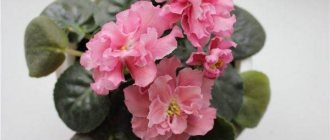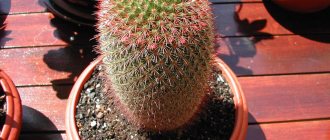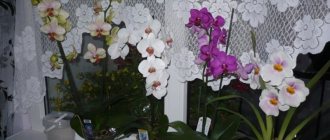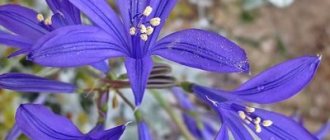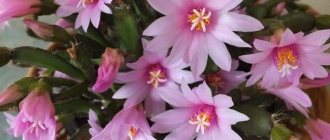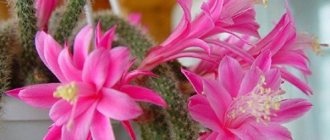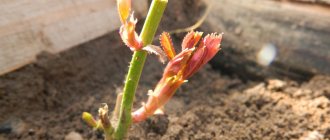Growing rebutia from seeds
https://youtube.com/watch?v=emGhaDhzUjU
In nature, rebutia reproduces excellently by self-seeding: the fruit cracks, the seeds fall to the ground and germinate, and soon small cacti appear not far from the mother plant. Flower growers use this method extremely rarely, because the seeds are small and not very convenient for sowing; they also need to be purchased at a flower shop.
The procedure includes the following steps:
- Fill wide containers with an earth mixture prepared on the basis of 2 parts turf soil with the addition of 1 part sand and the same amount of peat;
- Level the soil surface and spray with a fine spray;
- Mix the seeds with fine sand for ease of sowing and distribute over the soil, as if pouring salt into a dish;
- Provide diffuse lighting and an air temperature of at least 22 °C;
- The seedlings will be very dense, thin them out using tweezers;
- When the seedlings grow to a height of 2 cm, they can be planted in separate containers.
Reproduction and planting of rebutia
Rebutia reproduces by lateral shoots (“babies”) and seeds. As the cactus grows, it produces many “babies”. They are separated and placed in a dry substrate. With the appearance of roots, small rebutias begin to be watered using a syringe or pipette.
At the end of flowering, the rebutia produces fruits in the form of green berries, from which many small seeds fall out when ripe. They quickly germinate next to the mother plant, forming entire colonies of seedlings.
The babies are dug out of the pot and seated in separate containers with a substrate consisting of :
- 1 part peat
- 1 part coarse river sand
- 2 parts of turf land.
We have prepared an interesting article for you about whether it is possible to eat citrofortunella fruits.
Coleus nettle will be a noticeable addition to any garden. Note to the gardener.
How to cope with calibrachoa reproduction at home? https://sad-doma.net/houseplants/dekarativnotsvetushhie/roskoshnaya-kalibrahoa-posadka-i-uhod-v-domashnih-usloviyah.html With these recommendations it’s easy.
Types of rebutia description and photo
Varieties and types of phlox description, photo
In nature, there are up to 19 types of rebutia.
The following plant species are grown in indoor floriculture:
Rebutia is tiny - the plant has a spherical stem up to 5 cm in diameter with a flattened top. The papillae are arranged in a spiral pattern on the stem. The flowers are red. It grows naturally in Argentina;
Rebutia Marsonera - stalk dimensions are 5 cm in diameter and 4 cm in height. This type of rebutia has yellow flowers. It grows in northern Argentina;
Rebutia senile - it has a relatively large stem (8 cm in height and 7 cm in diameter). The flowers are large (up to 3.5 cm in diameter), red. The plant is native to Argentina.
Considering the types of rebutias in the description with photos, you can choose the appropriate varieties for your indoor window sill:
In addition, there are such types of rebuttal as:
Rebutia marsonerii Werd. It is distinguished by rusty-brown bristle-like spines and large canary-yellow flowers.
Rebutia kariusiana Wessn. is a recently discovered rare species with a pink corolla of magnificent flowers.
Rebutia violaciflora Bckbg. belongs to the most famous species. The plant has thin brown-yellow spines and glowing pink-purple flowers.
Rebutia senilis Bckbg. has the densest and shortest glassy white bristles. The flowers are red. Numerous varieties of this species have all kinds of thorns and flowers from yellow and orange to pink.
Rebutia minuscula K. Sch. has a pale green stem up to 5 cm in diameter and early, fiery red flowers.
Rebutia Aylostere albiflora. Globular cacti forming small groups. The diameter of the stems is 1.8-2.5 cm. There are 14-16 ribs, they are with tubercles. There are about 5 central spines, up to 15 radial spines.
Rebutia schatzliana. Spherical solitary cacti. The diameter of the stems is up to 1.5 cm. There are 16 ribs, they are with tubercles. There are 0-2 central spines, up to 13 radial spines.
Rebutia Weingartia arenacea. The diameter of the yellow-green stems is 2.5-5.0 cm, their height is 2.0-3.5 cm. There are about 30 ribs, they have distinct tubercles. Spines 14-16.
Rebutia brunescens. Single spherical cacti with reddish-violet stems. Their diameter is 5 cm. There are 13-14 ribs, they have rounded tubercles. Central spines 0-2, radial spines 11-13.
Rebutia cardenasiana. Spherical single cacti up to 5 cm high and up to 8 cm in diameter. There are 14-16 ribs, they are arranged in a spiral, with tubercles. Synonyms: Sulcorebutia cardenasiana. Weingartia cardenasiana.
Rebutia Weingartia cylindrica. Cacti form small groups. The height of the stems is up to 12 cm, diameter - 4-5 cm. There are about 16 ribs. There are up to 4 central spines, 10-12 radial spines.
Rebutia fabrisi. Cacti form small groups. The height and diameter of the stems is up to 2 cm. The ribs are arranged in a spiral, with tubercles. The spines are numerous, 4-8 mm long. The length of the red flowers is 2.5 cm.
Aylostera fulviseta. The height of the dark green stems is 1.5 cm, the diameter is 1.0 cm. There are up to 16 ribs, they are with tubercles. There are 1-3 central spines, their length is up to 1 cm; radial spines - 10-12.
Rebutia gonjianii. The height of the dark green stems is up to 2 cm, diameter -2.5 cm. There are up to 38 ribs, they have tubercles arranged in a spiral. The spines are only radial, there are 24-26 of them.
Rebutia huasiensis. Single spherical cacti with purple stems. Their height is 7 cm, diameter is 3.5 cm. There are 13-14 ribs, they have wild-shaped tubercles. Central spines 0-1, radial spines 7-8.
Rebutia narvaecensis. Cacti form small groups. The height of the gray-green spherical stems is 3.0-3.5 cm, the diameter is 2.5-3.5 cm. There are about 18 ribs. The areoles are round and white. Needles 10-20.
Rebutia perplexa. The height of the light green stems is 1.2-2.0 cm, the diameter is 1.2-1.5 cm. There are 16-18 ribs, they are arranged in a spiral. The areolas are round and white. There are 10-16 needles, they are golden, only 1-2 mm long.
Rebutia ritteri. The height of the stems is 5 cm, the diameter of the stems is 3.5 cm.
Rebutia pulvinosa. Cacti form small groups. The diameter of the stems is 3 cm. Ribs with tubercles. Areolas are round. There are up to 6 central spines, 15-22 radial spines.
Rebutia spegazzmiana. The diameter of single stems is 2.5 cm. There are 13 ribs, they are with tubercles and arranged in a spiral. There are 1-4 central spines, they are up to 7 mm long. radial spines 11-13.
Rebutia spinosissima. Cacti form dense “cushions.” The height and diameter of the stems are 4 cm. There are about 15 ribs. There are 5-6 central spines, there are many radial spines.
Rebutia steinmannii. The height of the stems is up to 7 cm, diameter - 8 cm.
Popular species of the genus Rebutia, their descriptions and photos
The genus Rebutia includes many species that differ in spines (size, color, location on the stem), the shape of the cactus body (elongated, spherical or flat), the size and color of the flowers. The most common and popular indoor varieties among gardeners are the cacti described later in the article.
Deminuta
The main difference from other varieties is the abundant branching at the base of the stem, which allows the cactus to exist in dense groups of several copies. It is also distinguished by its size: the height of the spherical stem reaches 10 cm, the diameter is 8 cm. The stem is dark green in color, pubescent with grayish spines, interspersed with long brown needles. The flowers appear at the base of the stem, have a rich red-orange tone and are funnel-shaped with the tips of the petals bent back.
Krainza (Krainziana)
The cactus is dotted with elegant thin silver needles. It blooms with large red flowers, shaped like a funnel. Most often they are located on one side of the stem. The plant itself and the flowers are identical in diameter - 4 cm.
White-flowered (Albiflora)
A variety of the Rebutia Krajnc cactus, distinguished from it by its white flowers. Their diameter is half as much - only 2 cm. Along with rebutia deminuta and albiflora, it has branched stems at the base and lives, forming groups of cacti. Small trunks are very fleecy due to the layer of thin light needles covering them.
Xanthocarpa
The flowers of a small graceful cactus rarely reach more than 1-2 cm in girth. The main highlight of the xanthocarpa salmonea subspecies is its delicate salmon color.
Important! The plant does not need cross-pollination.
Narvaecensis
The cactus has the shape of a ball, strongly pressed on top, with a diameter of 4 cm. A group of narvasensis can reach 12 cm in diameter. In spring, delicate three-centimeter cups of pink flowers appear on the trunk. The flowering period can last several months. The variety does not tolerate waterlogging of the soil and is easily affected by rot.
Perplexa Donald
The species originates from southern Bolivia. The narrow tall stem reaches dimensions of 8 cm x 1.5 cm. Branching at the roots allows the formation of dense groups. The trunk of the cactus is covered with spirally curved ribs. The light green stem of a grayish tint is strewn with lateral and central brown spines 2-5 mm in length, visible through the brown pubescence of the cactus.
Reference! It differs from other varieties in that it tolerates keeping in the shade very well. The flowers are funnel-shaped and open during the day. Inflorescences measuring 4 cm x 4 cm are distinguished by the bright pink shade of the petals.
Sulcorebutia Arenacea
Sulcorebutia differs from rebutia in its large rhizome, shaped like a turnip fruit. Stronger, prickly and durable needles grow from the center of the elongated tubercles. The culture comes from Bolivia. The trunk has a flattened spherical shape. Color – dark green, brown. The height of the cactus is 3 cm, its diameter reaches 6 cm. It is covered with spirally arranged ribs, decorated with tubercles and thin curved spines of yellowish or brownish tints. Light yellow flowers with a gray tint may have an unpleasant aroma.
Kariusiana
Comes from Argentina. The spherical trunk, 4-5 cm tall, has a width of about 5 cm. It is evenly dotted with tubercles with thin light needles from 4 to 20 mm (depending on the plant itself). It lives in colonies and blooms with small pale pink flowers (you can learn about cacti with pink flowers here).
Violaciflora
The light yellow-green stem is pressed down from above, the diameter of the plant is 5 cm. Thin spines of yellowish-brown tones reach 1.5 cm in length. They grow on the sides and in the center. 3-3.5 cm is the girth of flowers consisting of pink or purple (hence the name) petals. With age, the species acquires a large number of spines.
Marsoneri
The flowering period occurs in spring. The dark green stem and brownish-reddish needles harmonize beautifully with bright orange or yellow flowers. Some hybrid plants may have reddish petals. Trunk dimensions: 4 cm x 5 cm, flowers about 4 cm in diameter.
Grandiflora
It stands out with large flowers on an elongated crimson tube. They can be up to 6 cm long and up to 4 cm wide. An adult specimen can grow up to hundreds of flowers. Homeland - Argentina.
Tiny (Miniscula)
The miniature species, slightly flattened on top, reaches 5 cm in diameter. Small silvery and brownish needles are arranged in a spiral. The small, tubular-shaped flowers are colored red. This beautiful little cactus comes from Argentina (you can learn more about the different little cacti here).
Senile (Senilis)
It has a spherical, slightly elongated stem, the height of which rarely exceeds 8 cm. It is strewn with numerous light (often white) three-centimeter spines. The flowers are small, red in color with a white center.
Canigueralii
The variety is more resistant to drought than other rebutias. Tiny bright red flowers are usually located at the top of a small ball-like stem. The flowers are bell-shaped; inside the cups there are bunches of yellow stamens. The spines of the canigueral are long and hard (are there any cacti without spines?).
We also recommend that you read articles about Astrophytum, Gymnocalycium, Mammillaria, Prickly Pear, Perescia, Ripsalidopsis, Rhipsalis, Cereus and Epiphyllum, Hatiora.
Reproduction of rebutia, growing cactus from seeds
Charming corydalis description, types and photo of the flower
The succulent can be propagated by seeds or “babies” (side shoots). The first method is more labor-intensive: in order to obtain a young plant from seeds, you need to adhere to a number of rules. First you need to collect seeds from an adult cactus. They are stored in a cool, dry place, and in early March they are sown in a moistened substrate. The soil should consist of sand, earth and charcoal in a ratio of 1:1:0.5. Expanded clay drainage is first placed at the bottom of the container. The substrate needs to be steamed to get rid of small insect larvae.
The seeds are treated with a weak solution of potassium permanganate, and then sown in the ground at a distance of 2 cm. The container is covered with film or placed in a greenhouse at a temperature of 17-21˚C, and the seed is moistened and ventilated daily.
An important part of growing amazing rebutia from prepared seeds is caring for the sprouts that have already appeared. They are planted in separate pots and protected from direct sunlight, temperature changes and excess moisture.
It is much easier to propagate the plant by lateral shoots: the rebutia branches well, and separating the “babies” from the stem is not difficult. After this, they are dried for a day and planted in a moistened substrate. This procedure is best carried out from early spring to mid-autumn.
Reproduction of the Rebutia cactus
Rebutia can be propagated by seeds and offspring. Let's describe each method in more detail.
Propagation by seeds
This method is more complicated. It is recommended to purchase seeds in specialized stores if you want to get an impeccable cactus variety. Seeds should be sown in early spring. The soil mixture for sowing is mixed from sand and ordinary soil (50:50). You can also add a little charcoal there. Before sowing, it is necessary to treat the soil with heat treatment (steam). Before sowing, the seeds are soaked for 15 minutes in a weak solution of potassium permanganate. The treated seeds are laid on the surface of the soil. The container with the seeds is covered with film or placed in a mini-greenhouse. During germination, the room temperature should be in the range of 16-20 °C. The soil surface must be regularly ventilated and sprayed with filtered water.
Young shoots appear after a few weeks and can be transplanted into separate containers. They should be protected from direct sunlight until they are 1 year old. During the first year, you need to constantly provide diffused light. After a year, the sprouts are gradually accustomed to adult life.
Water the plants moderately, as young shoots react negatively to excess moisture.
Reproduction of Rebutia by children
The cactus produces many side shoots. The shoots grow independently as individual cacti, but they are permanently connected to the mother plant by a small isthmus. Children are cut off from the mother plant when they become very large. As a rule, seedlings take root from spring until the start of the dormant period. This is the best period for successful rooting.
The babies are dried for 24 hours and then placed in a moist, warm substrate. Before planting the seedlings, the soil is sterilized. Young shoots can also be rooted in wet sand.
Pests and diseases of rebutia
Rebutia diseases and how to treat them
Miscanthus description, propagation, care, planting, use in the garden, photos, varieties and types
Sometimes cork formations appear on the rebuttion. This happens as a result of mechanical damage to the stem, hypothermia or insufficient watering in the summer. And if you water the plant during the dormant period, when it is in a cool room, it may develop stem rot. If this happens, you need to stop watering and let the stem dry out. Nitrogen fertilizers applied at the wrong time or in too large quantities can lead to rotting of the rebutia root system. Try to follow our recommendations, and your cactus will never get sick.
In the photo: Growing rebutia at home
Rebutia pests and their control
Rebutia, which is quite resistant to diseases and pests, is sometimes affected by red spider mites, scale insects or mealybugs. Scale insects and scale insects must be removed from the plant with a cotton swab soaked in alcohol, after which the rebutia should be treated with Actellik or Fitoverm solution. The same drugs are also used against ticks. For preventative purposes, inspect the rebutia as often as possible and wipe it with a brush soaked in alcohol.
Pests and diseases
Rebutia has a dangerous enemy - the red spider mite. This miniature pest is very difficult to notice. Its presence can be detected by the following signs: light dots form on the skin of the stem and it acquires a silvery tint.
When there is a massive accumulation of mites, a cobweb is observed. The pest is destroyed using the drugs Actellik, Intavir, Neoron. For prevention, you can spray the rebutia with water with the addition of an insecticide a couple of times a season.
With poor care and waterlogging, rebutia can be affected by stem rot. The affected area should be cut out, the soil should be disinfected with a fungicide, and the living conditions should be improved.
Rebutia transplant at home
Rebutia is replanted in early spring before the flowering period begins. It is advisable to handle it together with a lump of earth so as not to damage the root system. The growth rate is fast, so replanting is required every 1-2 years. For planting, take a wide plastic pot of medium depth. Place a drainage layer on the bottom (pieces of foam plastic, clay shards, pebbles, expanded clay), which should fill ¼ of the container. The bush grows in width, so some of the side shoots need to be separated. Wear gloves to avoid pricking your fingers.
The soil required is moderately fertile, loose, light, neutral or slightly acidic. You can use a universal substrate for succulents and cacti or make your own. Take 2 parts of turf soil, 1 part each of leaf humus, charcoal and some brick chips.
After replanting, it is useful to place decorative pebbles on top of the substrate, which will protect the soil from drying out and improve the condition of the earthen ball, allowing the roots to breathe, and also reduce the amount of watering.
Main types - description of popular Rebutias
Only a few varieties of the genus have taken root in home culture , although all types of Rebutia are ideal for growing in an apartment due to their modest care requirements, small size and lush flowering.
Rebutia senilis
A native of the northern regions of Argentina . An equally whimsical species of the genus is ideal for beginners.
Rubutia senilis is distinguished by fiery red flowers with downward curved, narrow corolla petals and multiple long spines of a silvery-white hue.
Reference! The stem of rich green color grows up to 7 - 8 cm. It forms children well.
Flowering is possible several times from early spring to mid-summer. Young seedlings from 1.5 years old are able to form buds. Self-pollinating species.
Tiny Rebutia (Rebutia minuscula)
Argentine cactus grows naturally in mountainous areas and the alpine belt.
The stem (up to 5 cm) has up to 20 rows of densely seated, voluminous tubercles, painted in a light green color. The faint areoles bear many short radial spines of golden or silver color; there are no central spines. Produces many children.
Tiny Rebutia blooms from the first days of March until the end of June . The flowers are bright red with oval-elongated petals. Self-pollinating species, easily produces viable seeds.
Violet-flowered rebutia (Rebutia violaciflora)
This Argentinean is a rare guest on our windowsills.
It is distinguished by its miniature size - the delicate green stem does not exceed 2 cm . White areoles on weakly defined tubercles form dense spines with a brownish-golden tint.
It has a longer flowering period - from mid-spring to August. Large flowers with elongated petals are painted in a soft purple hue .
Rebutia marsoneri
It is distinguished by sunny yellow flowers and a dense network of spines with a brownish-rusty tint.
Rebutia Marsonera has a barrel-shaped stem (up to 5 cm) with frequent, small tubercles.
A characteristic feature of the species is the absence of children or their low education.
Reference! Flowering occurs throughout the spring. It is a cross-pollinated species, so different specimens are required to produce seeds.
But photos cannot convey all the luxury and sophistication of flowering cacti of the genus Rebutia.
This video will tell you about some types of cacti.
Diseases and pests
Rebutia is resistant to diseases, but if it is not properly cared for, difficulties arise and pests appear extremely rarely.
Root rot can develop from waterlogged soil. It is better not to allow this to happen, as the cactus will die. At the initial stage, an emergency transplant will help. Urgently remove the plant from the pot, cut off the rotten roots, treat the remaining parts with a fungicide to kill pathogens and transplant the cactus into a new container with fresh substrate.
If you notice whitish spots on the stems, the rebutia is affected by a mealybug, you need to spray the plant with a solution of the drug Karbofos.
Spider mites are small reddish insects that leave secretions in the form of threads of cobwebs. Use an acaricide against them.
Diseases and pests
The causes of cactus diseases are violations of care regimes . Abundant and frequent watering or unsuitable substrate lead to the appearance of rot (stem or root). Care methods should be adjusted, damaged areas should be removed and the cactus should be treated with a fungicide.
Carefully! Burying the root collar into the soil leads to the formation of rot - the cactus on the soil surface must be supported by drainage pebbles.
Insecticides and acaricides help fight against pests (red and spider mites, felt insects, scale insects) . Preventative examinations of the cactus are useful.
Caring for rocky cereus
Caring for rocky cereus cacti is quite simple. If you want to get a large plant, the soil should be nutritious, with a slightly higher content of clay-turf component. Cereuses are fast-growing cacti and respond well to abundant watering during the growth period, as well as periodic spraying and watering with a weak solution of mineral fertilizers. The stems of these plants can be washed under running warm water.
Rocky cereus tolerate prolonged exposure to low light conditions (which is why they are often used in interiors). But for normal development, these plants need a lot of sunlight, especially in summer. At least near a south or south-east window, or better yet, in the open air or in a greenhouse (however, if placed in the open sun immediately without prior preparation, the rocky cereus can get seriously burned).
Rocky cereus are resistant to diseases and pests, but the complex structure of their surface creates excellent shelters for parasites - mites, scale insects, and scale insects. Among the numerous branches, tubercles and spines of arthropod pests, firstly, it is difficult to detect in time, and secondly, it is difficult to destroy not only mechanically, but also with pesticides. But even with decent care of cereus plants at home, these unusual plants, unfortunately, practically do not bloom in cultivation.
Rebutia cactus description
Rebutias have perfectly spherical ribbed stems covered with a large number of spines. These plants reach a height of 5-6 cm, but sometimes they can grow up to 10 cm. The ribs on the stems of rebutia are low, weakly expressed, arranged in a spiral and divided into tubercles. There are at least 11 ribs on the stem. Each areola can have up to 30 heterogeneous, thin, bristle-like spines: radial spines up to 5 mm long and central spines up to 3 cm long. Due to the abundance of spines, rebutia cacti look like fluffy balls. Quite large single, glossy, funnel-shaped, wide-open flowers of orange, yellow-orange, red or orange-pink hue are usually formed in the lower areoles of the lateral surface of the stem, forming a girdle wreath. You can distinguish Ailostera from Rebutia by the structure of the flower: if you look closely, in Ailostera the pistil is half fused with the pubescent tube, while in Rebutia the tube is smooth and unfused.
Species of rocky cereus
Rocky cereus has firmly taken pride of place among common indoor flowers due to its bizarre shape, vitality and longevity. “Rocky” is not a species or varietal name, but a designation of growth form. Rocky or monster plants are found among the normal plants of many cactus species. But rocky cereus are most widespread. It is believed that rocky forms of two species are common in culture - Cereus repandus (=peruvianus) and C. jamacaru (yamakaru). However, it is likely that among the “monstrous” diversity there are forms of other species. It is very difficult to clarify the species identity of a particular rocky cereus, since the characters used in taxonomy are practically not expressed in rocky forms.
When describing this Cereus cactus, it is worth noting that the rocky form is already evident in tiny seedlings. But sometimes (and specifically in cereuses) monstrousness begins to form in adult, previously quite normal plants - on new growth (apical or lateral).
Rocky cereus are very diverse in appearance. They can be predominantly columnar or highly branched, with many small tubercles or with large, widely spaced convexities, with powerful spiny or thin corymbose spines of different colors. These plants live a long time and do not lose their decorative properties with age.
Look at the photo - Cereus cacti can reach respectable sizes, or, like bonsai, they can remain unnaturally miniature:
Rocky cereus can withstand unfavorable conditions, under which they can stop growing for several years without any visible damage, and then continue to develop as if nothing had happened. If - which happens very rarely with these plants - some shoots of the rocky cereus “stretch” due to lack of light, the general whimsicality of the form conceals the emerging flaws. The rocky shape hides both scars and traces of disease. All this ensures the widespread use of rocky cereus for decorative purposes.
Caring for the plant - care features
Despite the fact that cacti are unpretentious and drought-resistant crops, they also need care, and this consists of creating the most favorable conditions for the growth, development and flowering of the plant:
- correct location of the flowerpot, providing a good level of lighting;
- desired temperature;
- correct watering depending on the time of year;
- feeding;
- transfer.
Where is the best place to place the rebuttal?
The cactus needs a lot of light, it loves the sun, bright lighting, and the best place for its exposure is southern, southwestern or southeastern windows. In summer, it is recommended to take the plant out onto an open balcony or place it in the yard. But if this is not possible and the flowerpot is located in an apartment, then you should take care of the flow of fresh air and frequently ventilate the room.
Optimal temperature and humidity
Like all cacti, Rebutia tolerates heat well up to 35 degrees in the summer, but during the winter dormant period it needs to be provided with a temperature of 6 - 8 degrees, a dry and bright room. Wintering in warmer conditions can result in the plant refusing to bloom. Cacti are resistant to dry air, so there is no particular need to regulate humidity.
How to water rebutia
In spring and summer, water moderately. After the soil dries, it will not hurt the plant to spend two or three days in dry conditions. In winter, cacti are practically not watered at all, provided that they are provided with a cold temperature. Excessive watering can be detrimental to the plant, since rebutia is susceptible to root rot. To avoid this problem, the soil must contain gravel or granite chips; they will not allow the soil mixture to compact and retain water.
Transplantation and soil
The plant is replanted as needed, when the cactus colony becomes crowded in the pot, but at least once every 2 years. The best period for this process is considered to be the moment when the cactus comes out of dormancy, awakens, and the growing season begins. If buds appear on the plant, you need to wait until the rebutia blooms.
The pot needs to be shallow, but wide in diameter, since the cactus branches well. It should also have a large hole at the bottom and excellent drainage, which will allow water to drain well when watering. When replanting a plant, you should not bury the root collar of the rebutia into the ground; you can secure the body of the cactus by making an upper drainage from pebbles. The composition of the substrate is a mixture of leaf and turf soil and sand in equal parts. Instead of sand, granite chips are sometimes added. In a specialized store you can purchase soil specially prepared for cacti.
What and when to feed
Feeding of rebutia is carried out during the active growing season, using fertilizer that is intended for cacti. You can use a universal complex version of the fertilizer, which has a low nitrogen content.
Rebutia, which is properly cared for at home, in accordance with the needs of the culture, will thank its owners with abundant flowering.
https://youtube.com/watch?v=bzbvlkvum2I
https://youtube.com/watch?v=bzbvlkvum2I
How to propagate a cactus
Almost all types of rebutia grown in apartment conditions are characterized by good branching. The side shoots form new cacti in the form of a dense, strong colony, but at the same time they are connected by a thin isthmus to the mother plant. They are separated and planted in other pots. This is the simplest and most productive way.
No one, of course, has canceled the method of propagation by seeds, which many specialized stores offer to buy. For sowing, a shallow bowl and a substrate intended specifically for cacti are suitable. At the bottom of the container, be sure to arrange a drainage layer, fill it with soil and lightly press it with a tamper. The seeds are scattered evenly over the entire area, and then sprinkled with sifted soil, covered with glass and placed in a warm place.
When the seeds begin to hatch, the container is moved to the light. The optimal room temperature for seed germination is 18 - 20 degrees. If the first thorns appear on the seedlings, then it’s time to pluck them.
Thanks to the ease of cultivation and care, a lot of hybrid forms of rebutia have appeared; these cacti have become a popular plant on the windowsills of apartments and offices.
Proper care of the rebuttal
Caring for a succulent is easy, so even a novice gardener can grow a flower at home. But there are several requirements for environmental conditions. Rebutia needs a bright place, protected from the midday sun in summer. East windows are ideal, near which you can place a succulent.
For a cactus, air humidity does not matter, but in the summer heat it is advisable to spray it with settled water at room temperature. During this time, the succulent should be in the shade or exposed to indirect sunlight. Caring for rebutia in normal home conditions involves proper soil moisture. In summer, regular watering is necessary, but it should begin only with the appearance of buds. They focus on the moisture content of the top layer of soil: it should not dry out. In autumn (September - October) watering is gradually reduced. In winter, the soil is not moistened: the exception is young plants that grow for no more than 2 years. Once or twice a month they are watered with a small amount of liquid without salts, and on sunny days from February-March the substrate is sprayed with soft water.
In winter, the rebution is placed in a cool room where the temperature does not drop below 0 °C. But there should be good natural lighting.
When caring for rebutia in winter, it is worth remembering that too high air temperatures during the dormant months lead to the appearance of a large number of side shoots and deformation of the stem. After this, the succulent may not bloom.
During the growing season, fertilizing is carried out with fertilizers for cacti. The main thing is not to exceed the amount of nutrients. High nitrogen content in the soil causes plant root rot.
An integral part of rebution care is replanting: for cacti, this procedure is carried out in early spring if necessary. But young succulents are replanted annually. The soil should be dry, and the transplanted plant should not be placed in direct sunlight.
Rebutia blooms in spring or early summer. After flowering, the plant can be taken out into the air. The cactus will feel good on the terrace or balcony.
Caring for Rebutia in indoor culture
Representatives of the genus are among the most undemanding plants in terms of care - even in the collections of beginners, cacti will feel safe if simple growing rules are followed.
Lighting and placement
Cacti of the genus belong to a small group of plants that prefer rich daylight and are not afraid of direct sunlight, provided there is good air circulation. Therefore, it is considered comfortable for them to be placed on window sills and loggias on the south-eastern or southern side of the house .
The cactus requires good lighting all year round. The plant reacts to a lack of light by refusing to bloom and losing its decorative appearance. In winter or on northern window sills, additional lighting is required.
Important! After the winter absence of hot sun rays, cacti gradually begin to accustom them to active lighting in order to prevent burns in specimens with small spines.
Temperature
Rebutia feels relatively good at temperatures from +5 °C to +35 °C. But ideally in summer the plant prefers 25 - 35 °C , and in winter (starting from the end of November) the temperature should be lowered to 10 - 15 °C with sufficiently dry soil. From the end of February, temperatures gradually return to summer normal.
Without a cold winter, the cactus will not form buds , flowering will be delayed for a year, and the stems of the plant can produce many children or change shape.
As a representative of high-mountain flora, Rebutia does not tolerate intense heat and stuffiness. In the summer months, the cactus should be regularly given air baths (active ventilation) or moved to the garden or balcony.
Watering and air humidity
During the active growing season, the cactus requires regular and moderate watering with breaks to dry the substrate - but it is forbidden to completely dry the soil.
Use settled water at room temperature.
In the autumn, watering should be gradually reduced, bringing the cactus to a minimum before winter dormancy.
Attention! In the morning, it is advisable to spray Rebutia with a fine spray bottle to prevent the accumulation of dust on its stem.
In winter, watering is canceled or tiny doses of water are used (at higher temperatures - up to +15 °C). The cactus easily adapts to any humidity in the room, but does not like dust.
Feeding
The cactus takes the application of fertilizers calmly - fertilizing has virtually no effect on the quantity and quality of flowering.
During active growth and only if clearly necessary, you can use fertilizers for succulents , but dilute them at half the dose indicated on the package.
Advice! When feeding cacti, you should be guided by visual observations: there is no need to fertilize if the appearance of the plant raises doubts about the appropriateness of this procedure.
Transplantation and substrate
Rebutia species do not have specific timing for transplantation . For young cacti, the soil is changed once a year, and adult specimens are replanted as needed.
Important! The procedure is carried out at the moment the cactus emerges from dormancy or after the end of flowering using the transshipment method in order to cause the least harm to the roots. A prerequisite is transplantation from dry to dry soil. Watering only every other week.
The substrate should be light, with good aeration - it is better to use ready-made soil for succulents .
This video explains the basic rules for caring for a cactus.
Description of the rubutia cactus
Family - cactaceae.
Rebutia cactus (crown - red crown) are dwarf cacti native to Argentina. It grows wild in many dry areas, such as Africa, America, Asia, and Australia.
Judging by the description, cacti of the extensive genus Rebutia are among the most popular small South American cacti among succulent lovers. They bloom beautifully and are relatively unpretentious when grown at home. The genus was described by Carl Schumann in 1895 and named after the famous French winemaker and cactus seller P. Rebout. However, when a few years later Schumann worked on his monograph on cacti, he demoted the systematic position of Rebutia to the subgenus Echinocactus. Currently, Rebutias are again considered representatives of a full genus, which includes 41 species of small and slow-growing cacti with weak needles.
Look what the rebutia cactus looks like in the photo, which shows the different phases of the vegetative development of the crop:
The distribution area of the genus is the eastern foothills of the Andes and the adjacent territory from Bolivia to the northwestern part of Argentina.
Rebutia is a miniature cactus no more than 5 cm thick with many spirally arranged papillae, from which thin whitish spines grow. An adult specimen produces many children.
This is an amazing and very beautiful plant, similar to a flattened ball, covered with large bright cone-shaped flowers of white, yellow, pink, orange and red after a 3-month winter dormancy. When the rebutia reaches a height of 6.25 cm and a width of 3.75 cm, it develops shoots that serve not only for beauty, but also for reproduction. The ribs of the rebutia are low and often divided into small tubercles, which are arranged in a spiral.
Due to its miniature size, the cactus is called tiny rebutia.
Further, the rebutia in the photo is shown in different formation options - flowering can occur at different times of the year:
Caring for rebutia at home
Growing Rebutia at home
Caring for rebutia at home does not involve any difficulties, since these are mountain plants that require a minimum of comfort
The most important thing in growing a cactus is to provide it with cool conditions during wintering (8-12 ºC), otherwise the plant will refuse to bloom in the future. When buying a cactus, do not forget to check with the seller what the optimal temperature for your rebution should be, because recently bred varieties are recommended to winter at 5 ºC, and frequent ventilation of the room is also a prerequisite: rebutias do not tolerate stale air and are very fond of changes between daylight hours and night temperatures
As for the period of active growth, at this time rebutias tolerate any temperature regime.
Rebutias are very photophilous and are not at all afraid of direct sunlight, so you can safely place them in the sun and not worry that the plants will overheat or get burned. But even the slightest shading of the rebutia will not do any good.
Watering rebutia
Rebutia normally tolerates infrequent waterlogging of the substrate, but try not to abuse it. Watering should be uniform and sufficient, and their frequency depends on the evaporation of moisture from the soil and the room temperature. In summer, one watering a week may be enough, but if there is abnormal heat, then you can water the rebutia more often. The frequency of watering in winter is determined by the same conditions: the temperature in the room, which is much lower than in summer, and the degree of evaporation of moisture from the soil, which is also low in winter. Consequently, rebutia is watered extremely rarely during the dormant period, and the rate of water consumption is also significantly reduced. If the plant overwinters in a warm room or grows children whose diameter does not exceed 3 cm, its watering should also be meager and infrequent. However, keep in mind that the transition from summer to winter watering and vice versa should be gradual.
Water the rebutia with water that has been standing for 24 hours, the temperature of which should be a couple of degrees higher than the room temperature.
There is no need to spray or wash cacti. Dust from plants is swept away with a soft brush.
Rebutia fertilizer
You don’t have to fertilize the rebutia at all, but fertilizing it once a month from April to September with a non-concentrated solution of special complexes for cacti will help you achieve lush flowering from the rebutia. Solutions should be applied only onto a moistened substrate.
In the photo: How rebutia blooms at home
Rebutia transplant
Rebutias are replanted in March, at the very beginning of the season, and only when their roots have completely mastered the substrate in the pot. For these plants, special soil for cacti or succulents is most suitable - light, permeable, sand-based and containing gravel. Do not water the substrate in an old cactus pot before replanting: the soil must be completely dry. Place a thick layer of drainage material at the bottom of the new pot, transfer the rebutia from the old pot to the new one and fill the remaining space with dry soil mixture. Place the plant in a warm and very bright place. The first watering of the rebution after transplantation is carried out only a week later. And in the next 2-3 months, also be very careful with moisturizing.
Rebutia flowering
Flowering of rebutia, like ailoster, begins in the second or third year of life and usually occurs in the summer. The flowers open only in clear weather, closing at night. Each flower lives for at least two days.
If, despite your efforts, the rebutia does not bloom, check whether all necessary conditions are met:
- the plant needs a lot of bright sunlight;
- in winter, the flower should be kept at a temperature no higher than 10 ºC;
- the substrate for rebutting must be well drained;
- In summer the plant is watered moderately, in autumn infrequently, and in winter it is better not to water it at all.
How to grow Rebutia cactus at home
Since these plants have naturally learned to withstand the harsh conditions of the highlands, they have become quite hardy. These numerous species of cacti have stable populations because they do not face any major threats. They are easy to grow at home. It is worth mentioning the conditions in which Rebutia will feel good and delight its owners with its flowering.
The soil
You can use purchased soil mixture for cacti and succulents or prepare it yourself. You need to mix coarse sand, perlite and fertile soil. Use all components in a 1:1:1 ratio. The main condition for the soil is that it must allow moisture and air to pass through well.
Lighting
It is necessary to provide indoor plants with a large amount of light. The cactus is resistant to direct sunlight, so windows facing south, east or west are an ideal place for a pot of Rebutia. Plants should also be taken outside in the summer. The cactus may stretch out in search of light and will not bloom in low light. If you have long nights in winter, you may want to consider additional lighting. To do this you need to use fluorescent lamps.
Photo of Rebutia species (in the picture they are presented as species of the genus Sulcorebutia or Sulcorebutia)
There are also varieties that grow well in the shade. These species cannot be immediately taken outside in the spring under open sunshine. They need to gradually get used to the sun. Otherwise, burns may appear on the skin.
Temperature
In summer the plant loves hot conditions with an ambient temperature of 25-35 °C, and in winter cool air of about 5-10 °C. Try to take the pot with the plant out into the open air in the summer, but you should take care of shelter from the rain. Rebutia requires good circulation of fresh air. In autumn, gradually reduce the room temperature. In winter there is a period of rest and Rebutia needs a dry and cool climate with good lighting.
If the air temperature in your home is too high in winter, the cactus will stretch and become deformed and will not bloom in the spring. It is worth considering a cooler room.
Humidity
In the natural environment where the cactus grows, there is constantly high humidity. Rebutia can be lightly sprayed during the dry season. Water for spraying must be clean and settled. The plant is sprayed when direct rays do not reach the surface of the cactus. Otherwise, burns will appear on the surface of the cactus.
Cactus care information
What soil is needed to grow cacti?
How to water cacti correctly to avoid mistakes in care
How to properly use fertilizer for cacti at home
Watering Rebutia
The cactus tolerates dry conditions well and does not require frequent watering. If you are growing a cactus indoors, you need to provide watering similar to natural conditions. In summer, you should water generously when the top layer of soil dries out (once a week). In autumn, watering is gradually reduced to once every two weeks. During the dormant period, try not to water Rebutia.
The cactus is picky about water quality. Water for irrigation is used filtered, distilled or rain. The water temperature for watering Rebutia should be at room temperature. Experienced gardeners add a few drops of lemon juice to the water once every couple of waterings.
Fertilizers
Fertilizing can be applied once a month during the growing season. For Rebutia, you need to use fertilizers with less nitrogen content. If there is too much nitrogen, the roots may begin to rot. The required ratio of complex fertilizer: nitrogen 9 parts, phosphorus 18 parts, potassium 25 parts. In winter, Rebutia is not fertilized.
Rebutia transplant
Young plants are replanted once a year. An adult plant should be replanted every 3 years or if necessary, when the stem outgrows its pot. A week before transplantation, you must stop adding water. Rebutia is transplanted into dry soil. Watering is resumed a week after the procedure. The pot should be moved to light shade.
The timing of replanting Rebutia depends on your climate zone. The cactus is replanted after the end of the dormant period, when it begins to grow. Rebutia is also replanted after flowering if it begins to bloom very early.
How to get Rebutia to bloom
In order for your pets to start blooming, they need to be provided with favorable conditions for flowering. What conditions must be met:
- in summer, provide the plant with a lot of light;
- In winter, the room temperature should not exceed 10 °C;
- The soil should be suitable, well drained;
- In summer, the cactus needs plenty of watering, but do not overdo it;
- In autumn, the frequency of watering should be reduced;
- Do not water the cactus in winter.

